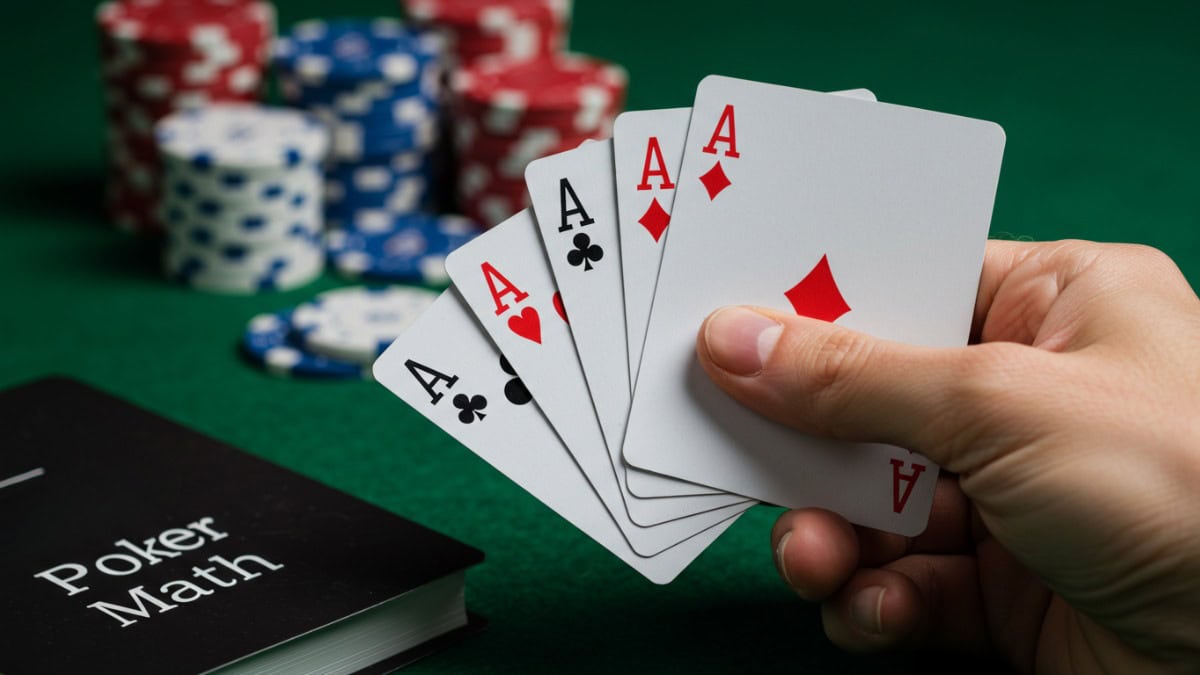
Poker Math & Probability
Poker is powered by mathematics—the core engine behind every strategic move at the table. While psychology can shape decisions, it’s mathematical logic that drives consistent, long-term profitability in the game.
In this guide, we break down the essentials of poker probability and why it’s crucial to winning strategy. You’ll discover the odds of landing specific hands, how often they hold up in play, and the process for calculating outs and winning percentages. We’ll also dive into pot odds—one of the most valuable tools for serious players—and show how to apply them to make sharper, more strategic choices.
Ultimately, mastering poker math not only strengthens your tactical advantage but also sharpens your mental discipline—allowing you to rely on data-driven decisions instead of chasing short-term outcomes. This commitment to analytical thinking is what separates top-tier professionals from the rest of the field.
What is Probability?
Probability is the branch of mathematics that deals with the likelihood that one outcome or another will occur. For instance, a coin flip has two possible outcomes: heads or tails. The probability that a flipped coin will land heads is 50% (one outcome out of the two); the same goes for tails.
Probability and Cards
When dealing with a deck of cards the number of possible outcomes is clearly much greater than the coin example. Each poker deck has fifty-two cards, each designated by one of four suits (clubs, diamonds, hearts and spades) and one of thirteen ranks (the numbers two through ten, Jack, Queen, King, and Ace). Therefore, the odds of getting any Ace as your first card are 1 in 13 (7.7%), while the odds of getting any spade as your first card are 1 in 4 (25%).
Unlike coins, cards are said to have “memory”: every card dealt changes the makeup of the deck. For example, if you receive an Ace as your first card, only three other Aces are left among the remaining fifty-one cards. Therefore, the odds of receiving another Ace are 3 in 51 (5.9%), much less than the odds were before you received the first Ace.
Pre-flop Probabilities: Pocket Pairs
In order to find the odds of getting dealt a pair of Aces, we multiply the probabilities of receiving each card:
(4/52) x (3/51) = (12/2652) = (1/221) ≈ 0.45%.
To put this in perspective, if you’re playing poker at your local casino and are dealt 30 hands per hour, you can expect to receive pocket Aces an average of once every 7.5 hours.
The odds of receiving any of the thirteen possible pocket pairs (twos up to Aces) is:
(13/221) = (1/17) ≈ 5.9%.
In contrast, you can expect to receive any pocket pair once every 35 minutes on average.
Pre-Flop Probabilities: Hand vs. Hand
Players don’t play poker in a vacuum; each player’s hand must measure up against their opponent’s, especially if a player goes all-in before the flop.
Here are some sample probabilities for most pre-flop situations:
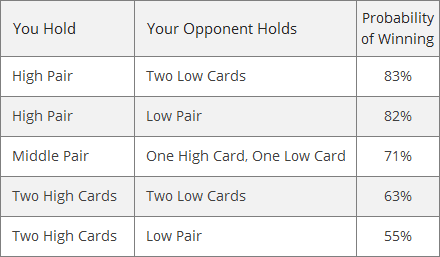
Post-Flop Probabilities: Improving Your Hand
Now let’s look at the chances of certain events occurring when playing certain starting hands. The following table lists some interesting and valuable hold’em math:
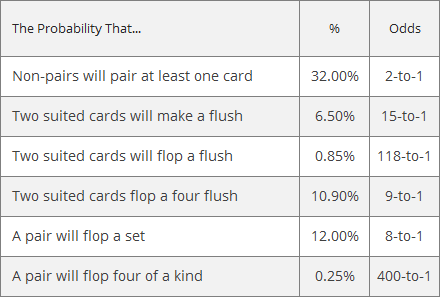
Many beginners to poker overvalue certain starting hands, such as suited cards. As you can see, suited cards don’t make flushes very often. Likewise, pairs only make a set on the flop 12% of the time, which is why small pairs are not always profitable.
PDF Chart
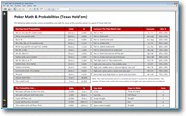
We have created a poker math and probability PDF chart (link opens in a new window) which lists a variety of probabilities and odds for many of the common events in Texas hold ’em. This chart includes the two tables above in addition to various starting hand probabilities and common pre-flop match-ups. You’ll need to have Adobe Acrobat installed to be able to view the chart, but this is freely installed on most computers by default. We recommend you print the chart and use it as a source of reference.
Odds and Outs
If you do see a flop, you will also need to know what the odds are of either you or your opponent improving a hand. In poker terminology, an “out” is any card that will improve a player’s hand after the flop.
One common occurrence is when a player holds two suited cards and two cards of the same suit appear on the flop. The player has four cards to a flush and needs one of the remaining nine cards of that suit to complete the hand. In the case of a “four-flush”, the player has nine “outs” to make their flush.
Also, note that in multiway pots (with more than two players in the hand), your actual chances of winning the pot are reduced, even if the mathematical odds of completing your hand remain the same.
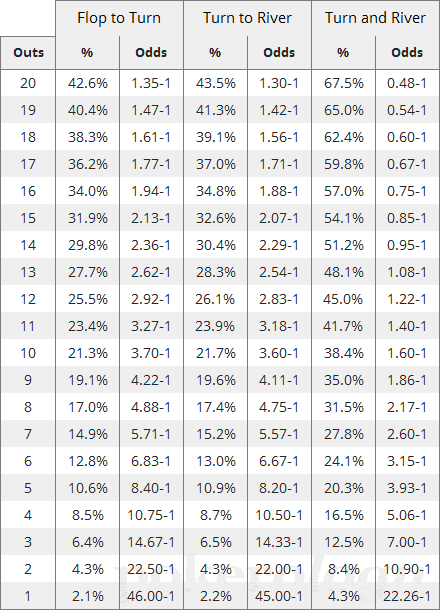
A useful shortcut to calculating the odds of completing a hand from a number of outs is the “rule of four and two”. The player counts the number of cards that will improve their hand, and then multiplies that number by four to calculate their probability of catching that card on either the turn or the river. If the player misses their draw on the turn, they multiply their outs by two to find their probability of filling their hand on the river.
In the example of the four-flush, the player’s probability of filling the flush is approximately 36% after the flop (9 outs x 4) and 18% after the turn (9 outs x 2).
Pot Odds
Another important concept in calculating odds and probabilities is pot odds. Pot odds are the proportion of the next bet in relation to the size of the pot.
For instance, if the pot is $90 and the player must call a $10 bet to continue playing the hand, he is getting 9 to 1 (90 to 10) pot odds. If they call, the new pot is now $100 and their $10 call makes up 10% of the new pot.
Experienced players compare the pot odds to the odds of improving their hand. If the pot odds are higher than the odds of improving the hand, the expert player will call the bet; if not, the player will fold. This calculation ties into the concept of expected value, which we will explore in a later lesson.
Bad Beats
A “bad beat” occurs when a player with slim statistical odds manages to win the hand—a frustrating moment, especially when probability favored you. Yet for players who understand poker math, these rare outcomes are simply part of the game. Unlikely doesn’t mean impossible—it just means infrequent.
How a player reacts to bad beats often reveals their emotional control and true experience level. Many seasoned pros insist bad beats are essential to poker’s long-term balance. The reason? Casual players often mistake luck for skill, treating a lucky win as proof of flawed strategy—opening the door for disciplined, strategic players to capitalize again and again.
Decisions, Not Results
One of the most important reasons that novice players should understand how probability functions at the poker table is so that they can make the best decisions during a hand. While fluctuations in probability (luck) will happen from hand to hand, the best poker players understand that skill, discipline and patience are the keys to success at the tables.
Conclusion
A strong knowledge of poker math and probabilities will help you adjust your strategies and tactics during the game, as well as giving you reasonable expectations of potential outcomes and the emotional stability to keep playing intelligent, aggressive poker.
Remember that the foundation upon which to build an imposing knowledge of hold’em starts and ends with the math. I’ll end this lesson by simply saying…. the math is essential.